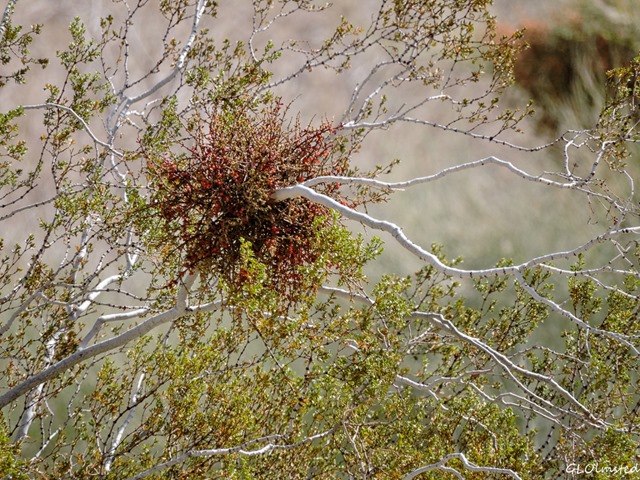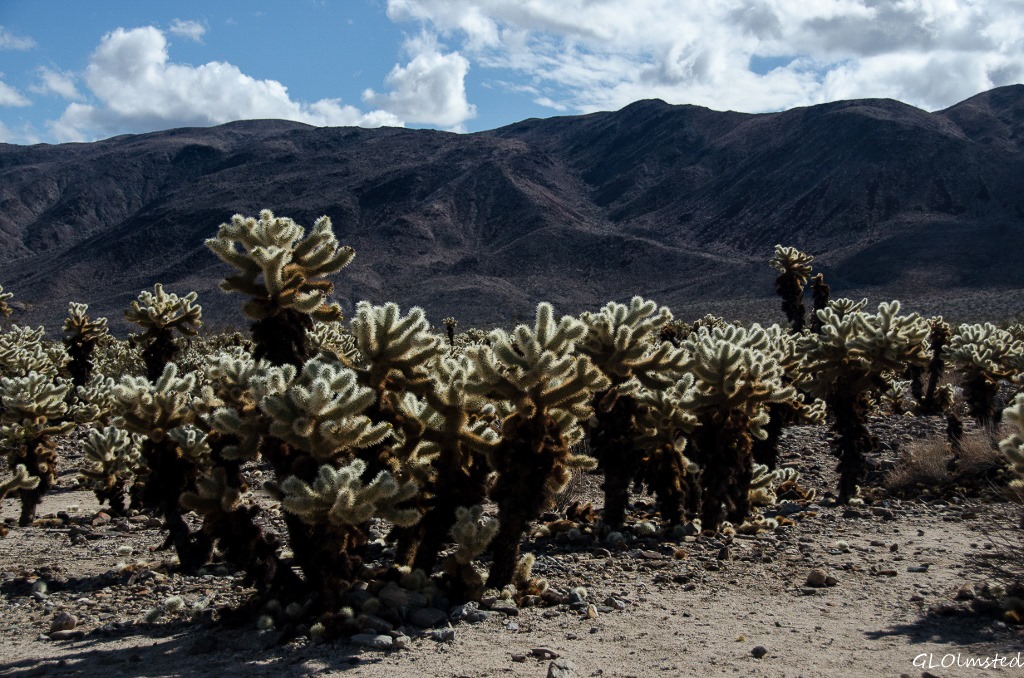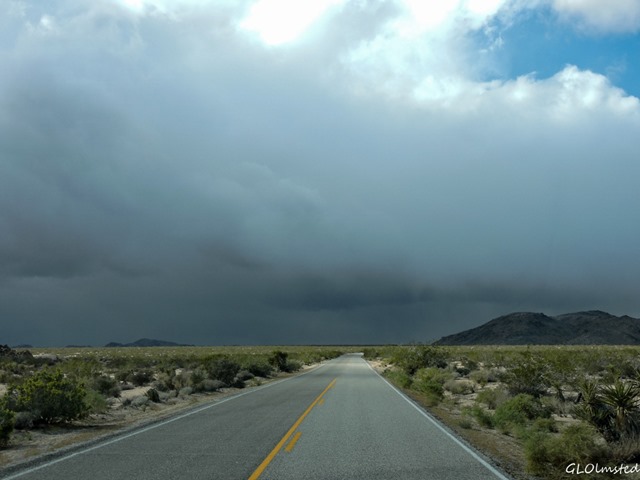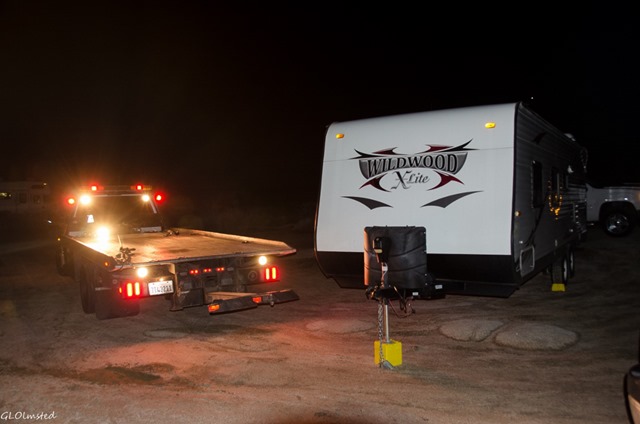Two deserts meet in Joshua Tree National Park, the lower Colorado below 3000 feet and higher elevation Mojave. My first day in the park, entering from the western entrance at Cottonwood, I spent exploring the lower desert of Joshua Tree.
 After avoiding the weekend crowd, and the rain, I left my free BLM campsite just outside the west entrance of the park driving over the 2800 foot Cottonwood Pass sandwiched between the Cottonwood and Eagle Mountains.
After avoiding the weekend crowd, and the rain, I left my free BLM campsite just outside the west entrance of the park driving over the 2800 foot Cottonwood Pass sandwiched between the Cottonwood and Eagle Mountains.
First stop, the Cottonwood campground to take advantage of their RV dump station. Although not a fun chore it’s a fact of life living on the road in a RV with holding tanks. Fill the fresh water tank and dump the black and gray. I can usually go three weeks, conservatively, and was on week two but planned to be in the park almost a week. I did get a bit of a cold shower when the water came out like a fire hose. It’s a double dump station with easy access and no extra charge over park entrance fees and I have a Park Pass for that. Even if you’re not in a RV this will be the last place for water until the eastern park entrances in 29 Palms at 38 miles (61 km) or Joshua Tree at 56 (90 km). So fill up those containers.
 Chores done, I stopped into the Visitor Center to ask about the mistletoe growing mostly on the scrub oaks. The bright red berries really stand out and I know mistletoe is a parasite so I wanted to know if it was native to this desert landscape. The Ranger informed me it’s considered a “semi-parasite” because it does absorb nutrients from its host plant but is also capable of photosynthesis so doesn’t typically kill the host unless there is too much growing on the tree or the tree is environmentally stressed due to extended drought. Many birds and small mammals eat the mistletoe berries then poop and spread them around. It is not considered a problem in the park.
Chores done, I stopped into the Visitor Center to ask about the mistletoe growing mostly on the scrub oaks. The bright red berries really stand out and I know mistletoe is a parasite so I wanted to know if it was native to this desert landscape. The Ranger informed me it’s considered a “semi-parasite” because it does absorb nutrients from its host plant but is also capable of photosynthesis so doesn’t typically kill the host unless there is too much growing on the tree or the tree is environmentally stressed due to extended drought. Many birds and small mammals eat the mistletoe berries then poop and spread them around. It is not considered a problem in the park.
 Being happy with that answer, I felt ready to continue into the park across the Colorado Desert landscape headed for White Tank campground, which at 3800 feet (1158 m) is in the other desert, the high Mojave. I could have hiked the 7.2 mile (11.6 km) round trip trail to Lost Palms Oasis starting just beyond the Cottonwood Springs campground but having recently explored palm canyons at Anza-Borrego chose not to. However I did drive through the campground which is of the old National Park design clearly set up with tent camping in mind. The parking for sites is small with only a few parallel to the road for larger RVs maybe up to 30 feet. It be tight. No hookups, pit toilets, and endless desert to explore but I’d stick with the free BLM camping outside the park.
Being happy with that answer, I felt ready to continue into the park across the Colorado Desert landscape headed for White Tank campground, which at 3800 feet (1158 m) is in the other desert, the high Mojave. I could have hiked the 7.2 mile (11.6 km) round trip trail to Lost Palms Oasis starting just beyond the Cottonwood Springs campground but having recently explored palm canyons at Anza-Borrego chose not to. However I did drive through the campground which is of the old National Park design clearly set up with tent camping in mind. The parking for sites is small with only a few parallel to the road for larger RVs maybe up to 30 feet. It be tight. No hookups, pit toilets, and endless desert to explore but I’d stick with the free BLM camping outside the park.
 Continuing on Cottonwood Springs Road which meanders across Smoke Tree Wash I was glad for the many paved pull offs because the shoulder looks soft. Not a safe place to be during a flash flood. I stopped many times to admire the spidery ocotillo, green-barked palo verde, smoke trees, patches of cholla cactus and the dominant creosote. Not much in bloom yet but the recent rains will bring that on soon. No Joshua trees yet as they grow at a higher elevation.
Continuing on Cottonwood Springs Road which meanders across Smoke Tree Wash I was glad for the many paved pull offs because the shoulder looks soft. Not a safe place to be during a flash flood. I stopped many times to admire the spidery ocotillo, green-barked palo verde, smoke trees, patches of cholla cactus and the dominant creosote. Not much in bloom yet but the recent rains will bring that on soon. No Joshua trees yet as they grow at a higher elevation.
 The Colorado desert is hot and dry, dry ground and dry air. Non-desert dwellers often miss the beauty found in these adaptive plants and animals living under a relentless sun, little water and summer temperatures over 100F (38C). I appreciate these survival skills even if I don’t want to be here in summer. Seeds can lie dormant for several years until conditions are favorable. The kangaroo rat, amongst others, obtains water from the food it eats. Most animals travel during the cool of night and I did not see them.
The Colorado desert is hot and dry, dry ground and dry air. Non-desert dwellers often miss the beauty found in these adaptive plants and animals living under a relentless sun, little water and summer temperatures over 100F (38C). I appreciate these survival skills even if I don’t want to be here in summer. Seeds can lie dormant for several years until conditions are favorable. The kangaroo rat, amongst others, obtains water from the food it eats. Most animals travel during the cool of night and I did not see them.
 The paved road turns northwest into Pinto Basin at a junction with Old Dale and Black Eagle Mine Roads which lead to mines outside the park and require 4×4. I headed across Turkey Flats, presumably named because of an unsuccessful try at poultry farming, and stopped at the Ocotillo Patch. Being the leaves of the ocotillo are rain dependent they can grow and drop as often as five times a year and the recent moisture had a few of them blooming with fire red tips.
The paved road turns northwest into Pinto Basin at a junction with Old Dale and Black Eagle Mine Roads which lead to mines outside the park and require 4×4. I headed across Turkey Flats, presumably named because of an unsuccessful try at poultry farming, and stopped at the Ocotillo Patch. Being the leaves of the ocotillo are rain dependent they can grow and drop as often as five times a year and the recent moisture had a few of them blooming with fire red tips.
 Next stop, the Cholla Cactus Garden, not a place to sit for a picnic, but the 1/4 mile nature walk guided me safely through a wonderland as the cactus spines glowed under an afternoon break in the clouds. You really don’t want to touch or even get near these “jumping” cholla as their spines easily embed in your skin and clothing but aren’t easily removed and can be quite painful.
Next stop, the Cholla Cactus Garden, not a place to sit for a picnic, but the 1/4 mile nature walk guided me safely through a wonderland as the cactus spines glowed under an afternoon break in the clouds. You really don’t want to touch or even get near these “jumping” cholla as their spines easily embed in your skin and clothing but aren’t easily removed and can be quite painful.
 Leaving the, slightly, warmer Colorado Desert through a transition zone into the Pinto Mountains and Mojave Desert the temperature dropped as the altitude rose and the last remnants of a storm passed over as I pulled into White Tank campground.
Leaving the, slightly, warmer Colorado Desert through a transition zone into the Pinto Mountains and Mojave Desert the temperature dropped as the altitude rose and the last remnants of a storm passed over as I pulled into White Tank campground.
 I actually enjoyed the soft rain which is a gift to the desert and received a rainbow gift in return.
I actually enjoyed the soft rain which is a gift to the desert and received a rainbow gift in return.

Sunshine returned and I walked no more than 1/10th of a mile from my campsite to Arch Rock. I looked for a way to get behind the arch for sunset but it would have required some serious bouldering which I didn’t want to do returning after dark.
 I backed into the last of 15 campsites off the turn around at the end of the loop in White Tank. None of the parking sites are big with some barely large enough for a small car. No water, pit toilets, $10/night or less with park passes. A sign at the camp entrance states nothing over a total length of 25 feet, and personally I think that would be pushing it. In fact just before dark, a man and his wife pulling a too long trailer hung it on the turn around and he had to disconnect and get a tow truck to get out. Poor guy, I’d have been freakin’ and frozen. Night temps got down to the high 30s.
I backed into the last of 15 campsites off the turn around at the end of the loop in White Tank. None of the parking sites are big with some barely large enough for a small car. No water, pit toilets, $10/night or less with park passes. A sign at the camp entrance states nothing over a total length of 25 feet, and personally I think that would be pushing it. In fact just before dark, a man and his wife pulling a too long trailer hung it on the turn around and he had to disconnect and get a tow truck to get out. Poor guy, I’d have been freakin’ and frozen. Night temps got down to the high 30s.
 The opportunities to climb and hop from boulder to boulder are many around White Tank and I went out in the morning for a little exploration. And there were Joshua Trees! I was in the Mojave Desert now.
The opportunities to climb and hop from boulder to boulder are many around White Tank and I went out in the morning for a little exploration. And there were Joshua Trees! I was in the Mojave Desert now.


